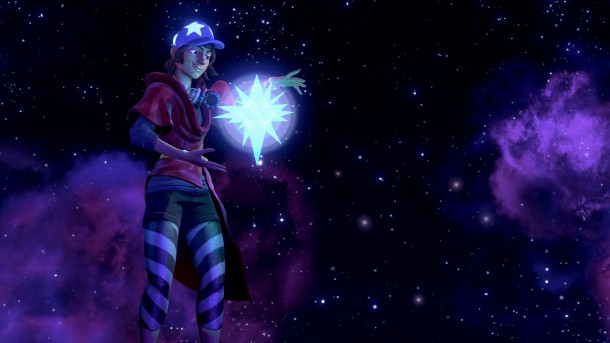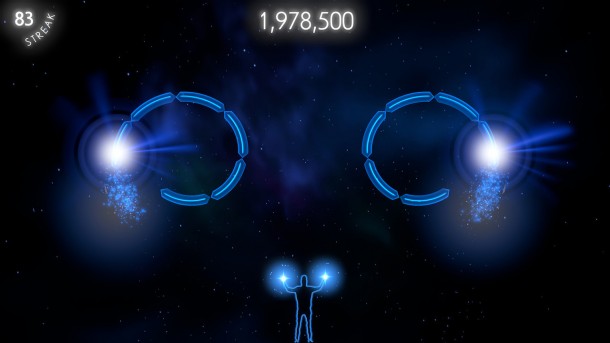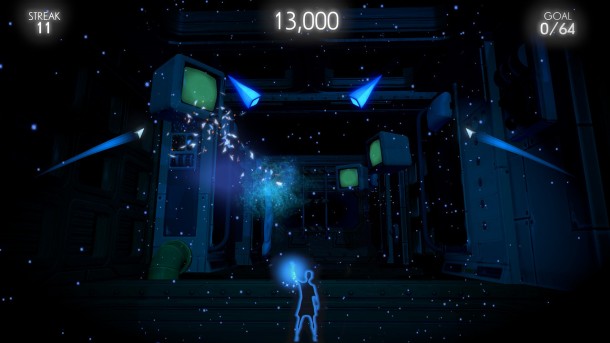
Their goal was straightforward: make the player feel as though they are in complete control of the heavens and the oceans. If you’ve ever watched The Sorcerer’s Apprentice short film, you can understand the allure and wonder of all that control as well as how quickly things can fall apart when they aren’t executed properly.
“The Disney team asked us to approach the game as a true continuation of the Fantasia legacy,” said Jonathan Mintz, Lead Designer on Disney Fantasia: Music Evolved. “To achieve this, we tried to understand the original inspiration behind the film: connecting people with music in new ways. We wanted to pursue that concept as a motion game, allowing players to physically shape and transform music.”
The team started by crafting a set of simple input gestures that could be woven together to create challenging sections in more complex songs.
“We wanted to give players a lot of freedom in how they play, so the cues are more about timing and direction rather than specific gestures,” Mintz said. “This is quite different from a game like Dance Central, where we ask players to master full-body motions.”

Anytime you’re creating a completely new gaming experience, not everything is going to work out.
“We certainly experimented with some cues that didn’t make the cut,” said Mintz. “At one point, we tried to create a ‘jazz hands’ cue to encourage players to rapidly wave back and forth. It was pretty funny to watch people try to perform those. In the end, though, we felt that simpler cues would serve the game better.”
Motion control design has a huge impact on the success of Kinect games and the staff at Harmonix have a two-step approach to building a responsive and enjoyable experience.
“First, we build the game around the Kinect, as opposed to trying to adapt an existing style of gameplay. Motions in Dance Central and Fantasia certainly have real-world analogs in choreography and conducting, but we adapt those motions to suit the strengths of the Kinect and build gameplay structure and scoring around that,” said Mintz. “Secondly, we build around music. It’s always easier to get moving when you’ve got a rhythm to groove to!”
With the input cues taken care of, the next step selecting the music to “groove” to.
“We began by picking some of our favorite classical pieces from the original film, then adding others that we thought would be musically rich and fun to play in the game, such as Dvorak’s New World Symphony,” Mintz said. “Next, we considered songs that had achieved classic status in the time since the original film, like Queen’s Bohemian Rhapsody.”
Finally, we looked for modern-day songs that offered compelling space to explore through gameplay and remixes. For example, we give players the chance to turn Bruno Mars’s Locked Out of Heaven into a ska rave-up. That serves as a great entry point for kids, giving them familiar current tracks that they can manipulate to discover surprises in their favorite music.”

Bringing all of these elements together in a unique and fun package took the input and skills of a wide variety of people at the Boston-based studio.
“The Harmonix team includes visual artists, composers, engineers, interaction designers, choreographers, and more,” said Mintz. “Fantasia challenged us to blend all of our skills. The original film was conceived as a fusion of color, sound, and motion. We wanted to make those elements fit together, and allow players to control the whole thing.”
“Each gameplay mode required long iteration on its own,” he said. “The biggest challenge was bringing all of the components of the game together. It took a ton of experimentation and playtesting to find a way to structure the game so that players of any age can understand the basic movements, master song performance, then go on to discover all of the songs, remixes, and musical interactions within the game.”
After spending the better part of two years working on Fantasia: Music Evolved, Mintz has become quite familiar with the original source material.
“Between watching the whole film several times, reviewing individual segments in team screenings, and studying the original animation cells and production notes from the Disney archives, it feels like we’ve been living and breathing Fantasia for a few years now,” said Mintz. “We have a huge amount of respect for the achievements of the original film, and we hope our interpretation serves as a fitting tribute to its ambition.”
Even though the game is now out, the team still has big plans for Fantasia: Music Evolved.
“We want to continue expanding the song library with more great music from all eras. Plus, we’re looking forward to taking the song remixes in even wilder directions. For instance, one mix pack lets you perform an intense, over-the-top speed metal version of The Police’s Message in a Bottle, which is a ton of fun.”
Only time will tell if Harmonix was able to reach their goal, but based on their track record with Kinect games, there might just be enough magic in their team to make Master Yen Sid smile.

![Breathing magic into Fantasia: Music Evolved [Interview with Lead Designer Jonathan Mintz]](https://www.sidequesting.com/wp-content/uploads/Fantasia-TheCliff-Scout-X2.jpg)

No Comments